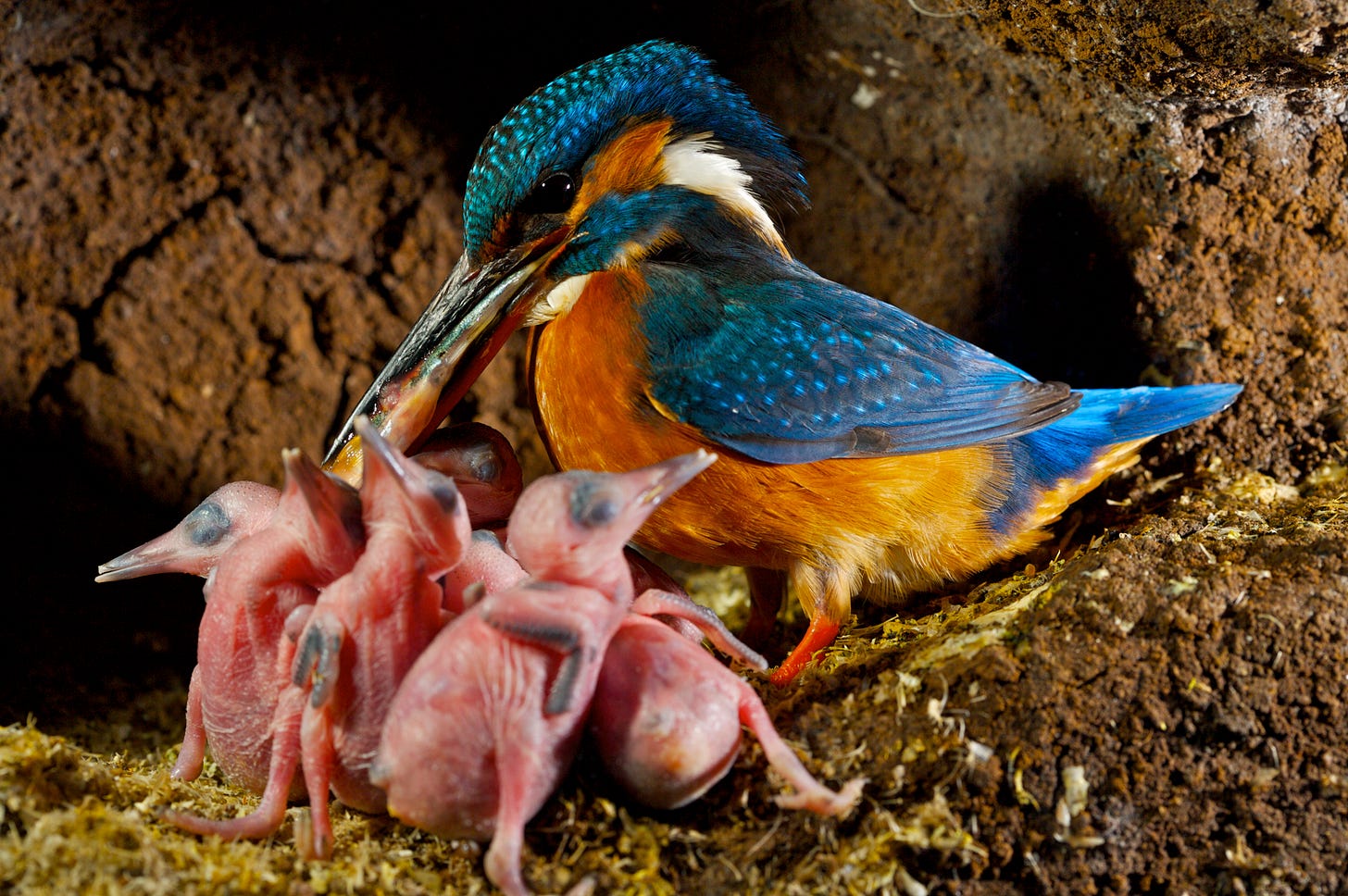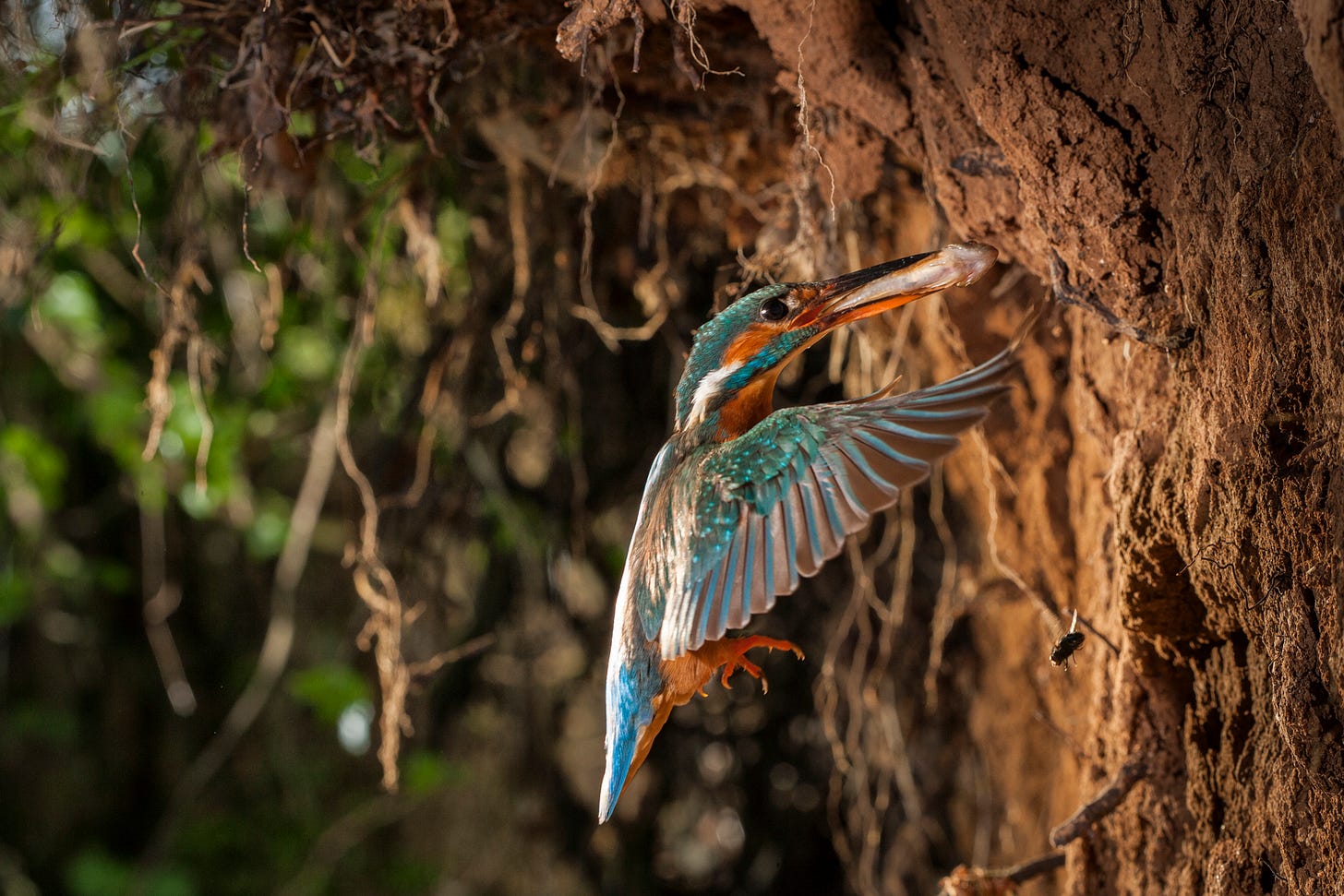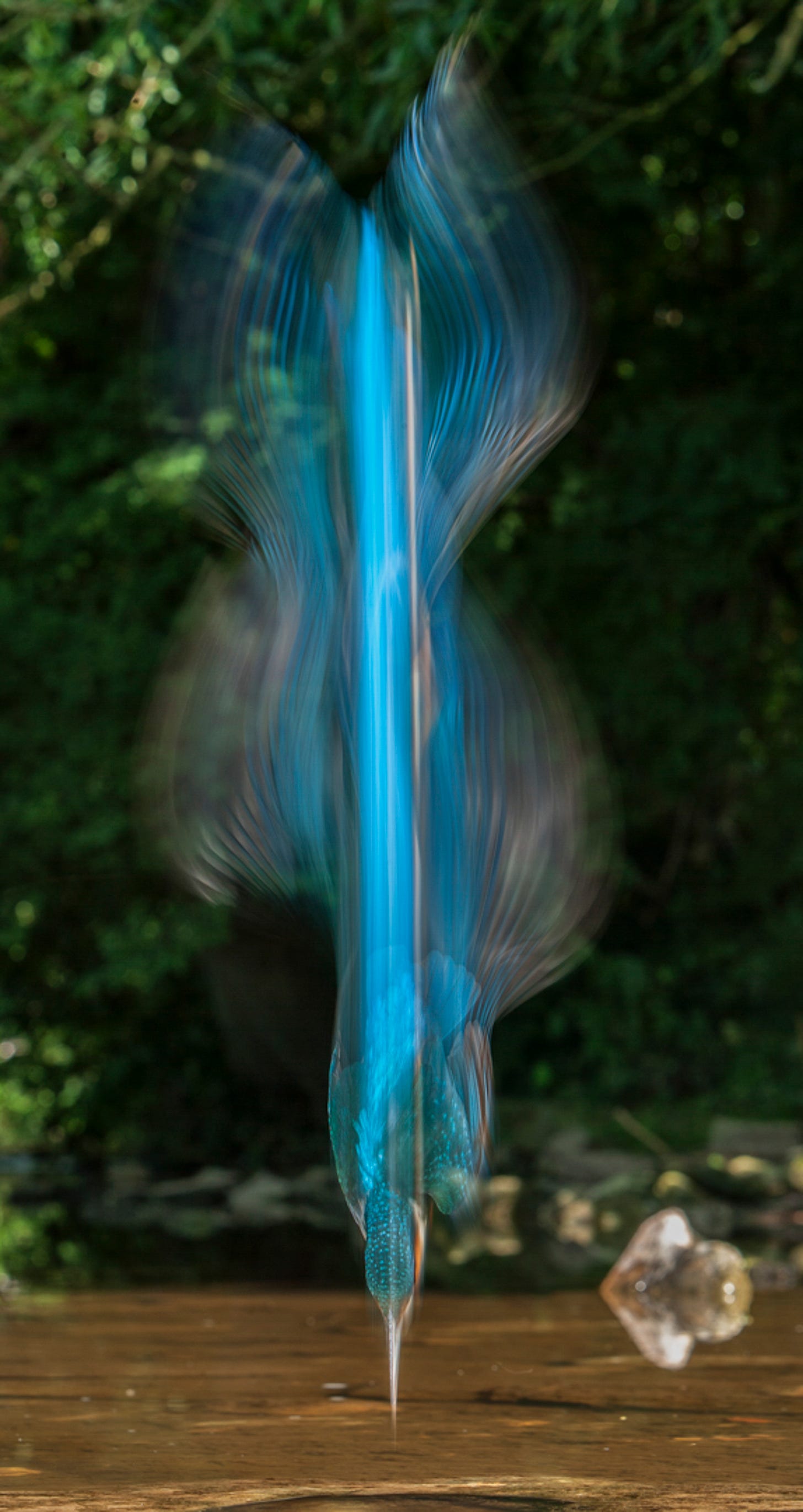This was the original first half of chapter 7 but it’s so boring that I chopped it out; however, if for some reason you’re interested in photographing kingfishers it may be of interest. I like to appeal to 0.00000000001 of the population in my writing...
Here goes...
I met Kathy Moran on a bridge in Bristol in 2003. She was smiley and warm, with a frizz of blonde hair and a soft, slightly girlie Delaware accent. She was with her friend Stella, whom I’d met the night before when she’d painfully grabbed and twisted one of my nipples in a bar. Jamie and I were there celebrating winning the cinematography award for My Halcyon River at the Wildscreen Festival, and I was also trying to drink away the shame and embarrassment of having made an acceptance speech so bad that the whole audience had collapsed laughing at me. It had ended with Jamie pretending to dig a hole on the stage behind me, and me saying, ‘I’ll get my coat’ and walking off.
Kathy was, back then, the senior natural history picture editor at National Geographic magazine. Stella explained to her that I was the idiot she’d seen on stage the previous night, and, while I blushed, Kathy flattered me with her thoughts on my film.
‘I want to work for you,’ I shamelessly admitted before waiting for her to finish.
‘Well, show me some pictures,’ she replied, a line she must have repeated a thousand times before.
I felt rather stupid and explained that I hadn’t taken a picture for years.
‘Well, if you can shoot stills like you shoot movies, then I’m sure we can do something.’
A week later I bought my first digital camera and a set of lenses, and began shooting pictures of kingfishers in what spare time I had between making films and trying to be a good father. I failed at both, of course, soon short-changing the commitment I had to my films and becoming so preoccupied with whatever new shot I had in my head that family life became an irritant. I was hopeless back then at managing the obsession that had always driven me.
I set about trying to comprehensively capture every part of the kingfisher’s life – courtship, feeding, mating, nesting in riverbank tunnels, aggressive posturing and fighting, and, of course, hunting. The river where I worked was often dark, closed in by trees and cursed too often with bad English weather, which meant that I struggled to capture fast-moving behaviour and usually ended up with blurry, flat images. Looking through the pages of National Geographic magazines, it seemed to me that the use of artificial light was what elevated their photographers above everyone else. Lighting was something I knew nothing about and the idea of it intimidated me. I struggled alone for a while with a couple of flashguns but the results were terrible. When I tried to find some decent books on lighting I discovered that there weren’t any, and certainly none on lighting wildlife.
So instead I decided to look at the works of portrait photographers to try and understand their process. I bought a book by Annie Leibovitz, whose photographs I loved. It detailed her lighting set-ups, which I studied and then tried to apply to kingfishers. Sometimes I’d work for weeks on a single image, tweaking the flashguns, adding or reducing light, experimenting with diffusers, shooting through leaves, introducing shadow, constantly playing to refine and perfect. Eventually I’d get a shot I was pleased with and I’d proudly send it off to Kathy. Occasionally she’d actually reply with ambiguous one-liners like ‘Sort your lighting out,’ which would hurt, but the knock-back always spurred me to work harder.
After months of trial and error I became quite proficient and took a series of images of kingfishers flying into their nest in the dark overhang of a riverbank. I’d assembled a lighting array of seven strobes, filtered some with a faint peach-coloured gel and lit the bird and background so carefully that I’d transformed the scene into a beautiful warm evening on the river, with the kingfisher perfectly frozen in flight, fish in beak, heading into its nest. I’d even lit the kingfisher at such angles that the blues of its body were exaggerated. I sent one shot off to Kathy, who didn’t reply; she just forwarded it on to Joel Sartore for comment. Joel, one of the most accomplished photographers on the planet, was a hero of mine. His reply came through the following day in an email exchange between the two of them that Kathy forwarded me without any comment from her: ‘Lighting looks a bit theatrical.’
I’d always heard that the National Geographic staff and contributors were tough, but I’d never realised just how tough they actually could be. I loved it, however. They couldn’t beat me hard enough. I’d become arrogant as a filmmaker; the job had become nothing more than a process of painting by numbers to make money to support myself and my family, and I’d lost interest in it as a result. Nothing excited me more than taking on something new and working for people I thought were better and smarter than me.
Back then my journey was all about showing off to myself that I could do anything I set my mind to. I began conceiving the most perfect images, then exhausting myself and my relationship with my family to make them even better. In the end I had a set of technically perfect images. They were cold, clean, well-lit, well-composed illustrations of a bird’s life. But there was something missing, and it took Kathy to point it out to me, something I’d never considered.
I almost never got to speak to Kathy on the phone; everything was done via what I assumed to be deliberately vague emails. But one afternoon, after I’d sent her a comprehensive portfolio of the images I’d shot over the previous few years, she phoned me up.
‘Can’t you give the bird some feeling of movement when it’s diving?’ she asked, and impressed upon me the idea that action needed movement to introduce emotion.
Despite having just made a film that had become famous for its emotional content over its technical proficiency, I’d never thought about how emotion might work in still photography. I took that idea away, spent a few sleepless nights considering it and eventually figured it out.
I found a spot along the river where a stand of thick bushes blocked the morning sun. Immediately downriver the bushes gave way to a horse drink, which let though full sunlight from dawn. If a kingfisher dived in this spot it would be lit by the sun, but set against a dark, almost black, background. I figured that if I shot the bird diving at high speed on a long enough exposure, then its beating wings, illuminated by sunlight, would show up bright against the dark background. I knew in theory that the image should be possible, and over the next few days shot a few images that confirmed my hunch. The problem was that they were just streaked blue blurs against a black background, with little comprehensible form. You couldn’t see what was creating the blur and so the images were simply too abstract for the magazine. I realised that I needed to freeze the bird at the bottom of the blur to make the shot readable.
After a week of fiddling and failing, and a lot of complicated balancing of camera settings, flash-gun outputs and a variety of angles, I finally got the technique dialled in. The bird needed to dive from its perch into the water no earlier than 7.30 in the morning, which then gave me about an hour before the light hit the river behind and ruined the effect. When the bird dived, I had to fire the camera, which was down in the river and wired back to me with a remote trigger in the hide. With the camera shutter open for a lengthy 1/8th of a second, the bird would leave the blurred trail of its sunlit-beating wings against the dark background as it dived vertically down through the frame. Just before its beak pierced the water, three flashguns would fire at the kingfisher, lighting it and freezing its movement. The problem was that I had to trigger the camera an 1/8th of a second before the bird was in the position I needed it to be in. So it took forever to get the shot.
The eventual image was, to me, about as perfect as a kingfisher image could be. The bird’s wings had left a ghostly, bright cerulean blue streak of blurred wingbeats. At the bottom of frame the beak, head and body of the bird were perfectly positioned to enter the water, wings tucked and daggerlike – a long blue flame stretching the entire extent of the frame above it.
Sending that image off to Kathy turned what had simply been a punt on her part into my first story in the magazine. It was unique, and pushed the boundaries of what was actually possible to achieve with a camera. It had effectively taken me six years to pull off, but I’d brought the technical skills and invention from wildlife camerawork into stills photography and caught Kathy’s attention. And she had taught me a very important lesson, whose importance back then I didn’t realise – the subject is nothing without emotion.
Two years later Kathy and Kurt Mutchler, the then head of photography for the magazine, gave me my first assignment – otters. The moment I signed that contract, which of course I didn’t bother to read, I’d made it. I was finally a National Geographic photographer.
I very quickly became bored of shooting straight wildlife stories. I always needed a new frontier to work towards and I found it in photojournalism, particularly conservation photojournalism. While continuing to make films and shoot magazine assignments, I began to develop my editorial style in my spare time. I knew that to move my work on I needed to stop thinking about photography simply as a medium for capturing images of animals, and start behaving and shooting like a photographer – but I had no idea how. So I pored over books and magazines, looking at the work of photographers I admired, examining their style and trying to understand what made it distinct from everything else.
I began relentlessly photographing anything I could turn into a subject, particularly family days out, which often annoyed me, so I’d occupy my time shooting my wife’s parents in the ugly, brash style of Martin Parr. I’d shoot portraits and weddings, where I’d try to choreograph the positioning of people within the frame, something I was hopeless at – and still am. I’d also harass my poor kids with a camera whenever they were doing anything photogenic, but especially when they cried. The more I shot, the more I learned, through failure and self-criticism. It was a process based, more often than not, on what I was doing wrong, rather than what I was doing right. But it took a technical cock-up to make me realise something that Kathy had already taught me a few years before.







For a shitty amateur nature snapper like me that gets lost in the process weeds, this chapter is far from boring. Thanks for making it available to read.
It was fascinating to read about the study and experimentation required to become a great photographer.